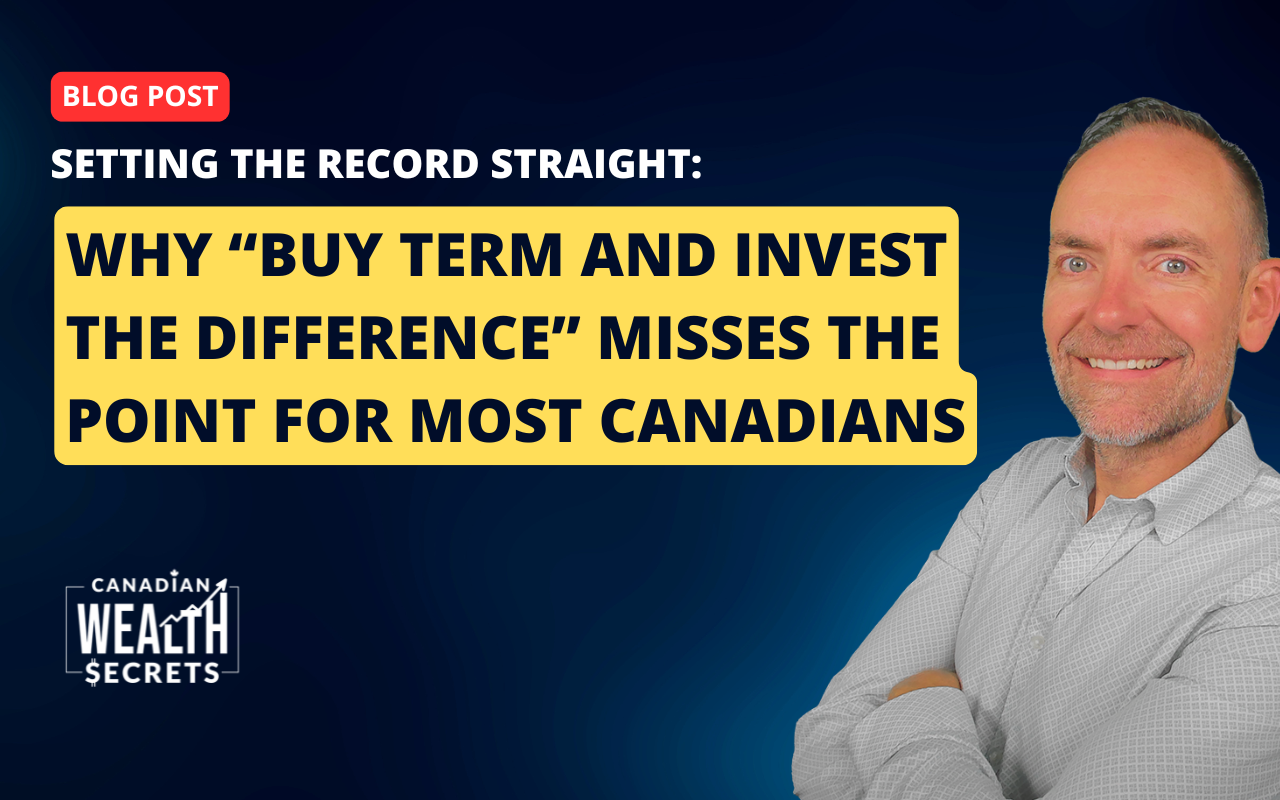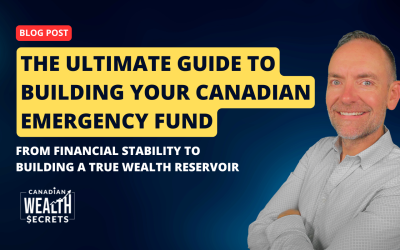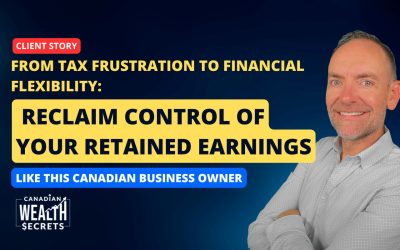Story: The Spreadsheet That Sparked the Conversation
A prospective client recently shared a detailed spreadsheet with me — one that perfectly illustrates why so many smart Canadians still misunderstand where permanent insurance fits in their financial system.
She’d mapped out a simple comparison. If she took $25,000 per year for 20 years, spent $5,000 on a 30-year term policy, and invested the remaining $20,000 in the S&P 500 (with a 15% average annual return), her spreadsheet showed she’d be better off investing on her own. By year 31, the investments would outgrow the $1 million term death benefit — even after tax.
Her conclusion was clear: “Why pay for whole life insurance when I can just buy term and invest the difference?”
It’s a fair question. One that Dave Ramsey, Primerica, and countless financial influencers have drilled into people’s heads for decades.
And in one sense, she’s absolutely right — if you’re comparing the wrong buckets.
The Core Misunderstanding
Most “buy term and invest the difference” comparisons assume every dollar you invest will chase equity‑like growth. But that’s not how most real portfolios work — especially for high-income professionals and incorporated business owners in Canada.
Most people aren’t 100% in stocks. Not even close.
When I look at client portfolios, I see something closer to a 60/40 or 50/50 mix — about half in growth-oriented, risk-on assets (stocks, real estate, private equity), and the other half in risk-off or conservative assets (fixed income, GICs, high-interest savings, or corporate cash).
So if we’re talking about where permanent life insurance fits, we’re not comparing it to your growth engine — we’re comparing it to your safety engine.
And that changes everything.
Lesson: It’s About the Right Benchmark
In my email reply to this client, I explained that her math made sense if she were evaluating high-early-cash-value participating whole life insurance against the S&P 500. But that’s the wrong benchmark.
The cash value in a properly designed high‑early‑cash‑value participating whole life (HECV par WL) policy is not meant to replace equities. It’s meant to replace or enhance your fixed income — the portion of your portfolio that prioritizes stability and access, not aggressive growth.
And when you compare like-for-like — risk-off vs. risk-off, after tax, and with liquidity and estate benefits factored in — the conversation changes dramatically.
Here’s why:
- Tax-Exempt Growth: The cash value inside a whole life policy compounds tax-free under Canada’s exempt test rules. That means no annual tax drag like GICs or corporate bonds.
- Liquidity & Control: You can access the cash value through policy loans or a bank line of credit, without selling assets or triggering tax. That creates a volatility buffer — a safety net when markets crash.
- Estate Multiplier: The death benefit pays out tax-free, often crediting the corporation’s Capital Dividend Account (CDA), allowing those funds to flow to your family or holding company tax-free.
If your fixed income earns 3–4% before tax inside a corporation, you’re likely netting 2–2.5% after tax and fees. A well-structured participating policy can often match or exceed that after tax, with far greater flexibility and estate efficiency.
The Bigger Picture: Risk-On vs. Risk-Off Money
Think about your wealth as having two different jobs:
- Risk-On Capital: Designed for growth. You expect volatility because it comes with higher long-term returns.
- Risk-Off Capital: Designed for stability. It’s your liquidity buffer, your emergency fund, and your sleep-at-night money.
The problem is, the “buy term and invest the difference” mindset assumes all your dollars belong in the risk-on bucket.
But what about the $200k or $500k sitting in your corporation “for safety”? Or the cash you’re holding for future opportunities? That’s your risk-off capital — and it’s usually the most underperforming money on your balance sheet.
When you move part of that money into a tax-exempt, liquid structure like a high-early-cash-value whole life policy, you give it a job: to quietly compound, remain accessible, and grow your estate.
A Realistic Canadian Example
Imagine you hold $500,000 in your corporation for liquidity and safety. Today, that money might earn 4% in GICs or short-term bonds. After corporate tax, you might net around 2.3%. Every year, tax slows your compounding, and your buying power erodes from inflation.
Now, let’s compare that to allocating $100,000 per year for five years into a high-early-cash-value participating whole life policy:
- The cash value grows tax-exempt, often with 85–95% liquidity after the first year (depending on design).
- You can borrow against it at roughly prime plus a small spread, giving you flexible access to your capital.
- The death benefit grows every year, and upon death, credits the CDA for tax-free distribution.
Same safety function. Very different long-term outcome.
Why Tax Drag Is the Silent Killer
The spreadsheet my client shared showed impressive compounding — but it ignored annual taxation on investment returns.
If you’re earning 4% in fixed income and losing 50% of that to corporate passive tax, your effective growth rate is only 2%. Over 20 years, that’s a major hit.
Whole life growth compounds tax-free. Even if the gross return looks modest, the uninterrupted compounding means you end up further ahead. Add in the estate benefit, and the gap widens even more.
When we compare properly — after tax, risk-adjusted, liquidity-adjusted, and estate-adjusted — the strategy often wins quietly over time.
Liquidity and Access: The “Volatility Buffer” Advantage
One point the client raised was that she could always borrow from a bank if she needed cash — so why borrow against a policy?
Fair question. The difference lies in control and timing.
During market downturns or tightening credit cycles, borrowing against traditional investments or unsecured credit can become difficult or unfavourable. Banks reduce credit lines, demand collateral, or increase rates.
With a well-structured participating policy, your cash value continues compounding and can serve as collateral for a policy or bank loan — even when markets are down. It’s unaffected by external volatility.
That makes it an ideal volatility buffer: when markets drop and you need liquidity, you can pull from the policy instead of selling equities at a loss. Then, when markets recover, you can repay the line — no harm done.
The Estate Efficiency Bonus
For Canadian business owners, the estate advantage of whole life is often overlooked.
When a corporately-owned policy pays out, the death benefit (minus ACB) credits the Capital Dividend Account (CDA), allowing your estate to distribute those proceeds tax-free. That can add hundreds of thousands in after-tax wealth compared to holding those same funds in taxable fixed income.
It’s not just about protecting against risk — it’s about building a more efficient balance sheet for the next generation.
How to Think About Returns — Without Breaking Out a Calculator
Let’s zoom out.
If your safe money earns 3–4% before tax and 2–2.5% after, but a participating policy compounds around 4–5% tax-free over the long term, you’re already in the same ballpark — maybe ahead. Now add:
- Liquidity through collateralization.
- A growing tax-free death benefit.
- The behavioral benefit of not selling equities in a downturn.
Suddenly, the spreadsheet math starts to look incomplete.
Where “Buy Term and Invest the Difference” Still Makes Sense
To be fair, “buy term and invest the difference” isn’t wrong — it’s just incomplete.
It’s great advice if you’re young, have limited cash flow, and want to maximize growth exposure while your time horizon and risk tolerance are high.
But for high-income professionals, incorporated business owners, and families building legacy wealth, the strategy starts to break down. You’re not trying to squeeze out every last percent of return; you’re trying to optimize for stability, liquidity, and tax efficiency.
Whole life doesn’t replace your growth portfolio. It replaces your least efficient assets — the money sitting idle, being taxed every year, and earning little in return.
The 3-Step Reframe
Here’s how I encouraged that client (and now, you) to think about it:
- Segment Your Capital. Identify what portion of your wealth is truly growth-oriented (risk-on) and what portion is meant to stay safe and liquid (risk-off).
- Compare Like-to-Like. Don’t compare whole life to equities. Compare it to your GICs, bonds, or corporate savings — after tax.
- Value Optionality. Liquidity and access matter. Whole life gives you the ability to borrow against your own capital while keeping it compounding tax-free.
When you frame it that way, the math — and the mindset — shift.
Setting the Record Straight
This client’s spreadsheet sparked a great discussion — one I wish more Canadians had before writing off permanent insurance as “too expensive.”
The truth is, buy term and invest the difference works only when you’re talking about growth capital — not the safety net portion of your wealth.
For most Canadians — especially those with corporations, retained earnings, and significant cash reserves — a high-early-cash-value participating whole life policy can make the risk-off side of your portfolio work harder, grow tax-free, stay liquid, and quietly build a bigger legacy.
It’s not about choosing between investing or insurance. It’s about aligning each dollar with the right job.
If this reframe resonates with you, ask yourself: What portion of my wealth is truly “risk-off,” and what is it earning after tax?
You might discover your safest money has the most untapped potential.
Have you taken our Wealth Health Assessment yet? You can do so free right here.
Ready for a conversation to discuss your personal or corporate wealth plan? Grab a spot in the calendar here.
Finally, if you’re an incorporated business owner, you should take our free self-paced masterclass on how to maximize your retained earnings.






